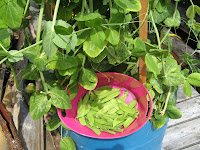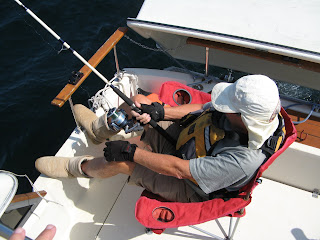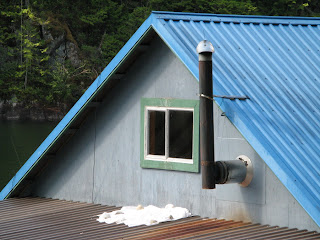View Larger Map
 We left North Sydney too early to stop for "The Best Tasting Chicken on the Island" (Cape Breton) at the Lick-a-Chick Restaurant in Bras D'Or. We saw it on our way north, but didn't have the time then either. You could smell the chicken cooking all the way out on the highway. The adjacent Lick-a-Cone didn’t look half bad either. Too bad, but we were looking for a breakfast stop.
We left North Sydney too early to stop for "The Best Tasting Chicken on the Island" (Cape Breton) at the Lick-a-Chick Restaurant in Bras D'Or. We saw it on our way north, but didn't have the time then either. You could smell the chicken cooking all the way out on the highway. The adjacent Lick-a-Cone didn’t look half bad either. Too bad, but we were looking for a breakfast stop. We pulled off the road at Baddeck along the Bras d’Or Lake. This is a long lake that is open to the ocean at both ends. There’s a marina here with large sailboats and cruisers. We walked down to the docks and then up the street to the Yellow Cello Café. It had a good business going, but we got a table inside and our breakfast was ready in no time. Benneck has two claims to fame. In 1885, Alexander Graham Bell and his wife Mabel discovered Baddeck and built a summer home here where they lived until their death in 1922. It is also the birthplace of Canadian powered aviation with the Silver Dart. Now it looks to be cottage country. Busy little place, then and now!
We pulled off the road at Baddeck along the Bras d’Or Lake. This is a long lake that is open to the ocean at both ends. There’s a marina here with large sailboats and cruisers. We walked down to the docks and then up the street to the Yellow Cello Café. It had a good business going, but we got a table inside and our breakfast was ready in no time. Benneck has two claims to fame. In 1885, Alexander Graham Bell and his wife Mabel discovered Baddeck and built a summer home here where they lived until their death in 1922. It is also the birthplace of Canadian powered aviation with the Silver Dart. Now it looks to be cottage country. Busy little place, then and now! Our drive today is backtracking down Cape Breton on Highway 105 to the Canso Causeway. We had to stop and wait for the bridge to close after three boats made it through the canal. After we junctioned with Highway 102 towards Halifax we decided to try a byway instead. We turned onto Highway 14, a two lane road through farming country. The crops of choice are hay and corn. There were also some dairies along the way. Here they bale their hay in rounds covered in plastic. It they sit in the green fields like giant white caterpillars.
Our drive today is backtracking down Cape Breton on Highway 105 to the Canso Causeway. We had to stop and wait for the bridge to close after three boats made it through the canal. After we junctioned with Highway 102 towards Halifax we decided to try a byway instead. We turned onto Highway 14, a two lane road through farming country. The crops of choice are hay and corn. There were also some dairies along the way. Here they bale their hay in rounds covered in plastic. It they sit in the green fields like giant white caterpillars. The coastal plain continues to be farm country. We saw vegetables such as broccoli, potatoes, onions, more corn and of course hay. The farms are small family operations with a house and barn near the road. Periodically there’s a small village with minimal services such as a general store and possibly a gas pump. Churches are important here. As you gaze across the green fields you will see a spire rising in the distance.
The coastal plain continues to be farm country. We saw vegetables such as broccoli, potatoes, onions, more corn and of course hay. The farms are small family operations with a house and barn near the road. Periodically there’s a small village with minimal services such as a general store and possibly a gas pump. Churches are important here. As you gaze across the green fields you will see a spire rising in the distance. At Highway 101 (no relation to our west coast Highway 101 that starts in Lund), we turned west for the Bay of Fundy. We decided to stop for an early dinner in Wolfville. This is the location of Acadia University. It has a restored downtown with quaint restaurants and shops. We ate at Paddy’s Brew Pub. Since it was Wayne’s turn to drive, I had their Annapolis Valley Ales. It was smooth and rich, just the way I like it. We grazed on appies and then headed out to the Bay of Fundy.
At Highway 101 (no relation to our west coast Highway 101 that starts in Lund), we turned west for the Bay of Fundy. We decided to stop for an early dinner in Wolfville. This is the location of Acadia University. It has a restored downtown with quaint restaurants and shops. We ate at Paddy’s Brew Pub. Since it was Wayne’s turn to drive, I had their Annapolis Valley Ales. It was smooth and rich, just the way I like it. We grazed on appies and then headed out to the Bay of Fundy. Just past Canning we found our campground for the night, Blomidon Provincial Park. It's located right on the Bay of Fundy, the location of the highest tides in the world. Our campground was right on the edge of the Bay of Fundy. It’s perched on a cliff of red earth with sweeping views of the bay. We had reservations, but when we checked in they were still assigning sites to drop in campers. Our site is large and protected by trees and shrubs. At least in our section of the park, you don’t feel like you’re crowded up against another camper.
Just past Canning we found our campground for the night, Blomidon Provincial Park. It's located right on the Bay of Fundy, the location of the highest tides in the world. Our campground was right on the edge of the Bay of Fundy. It’s perched on a cliff of red earth with sweeping views of the bay. We had reservations, but when we checked in they were still assigning sites to drop in campers. Our site is large and protected by trees and shrubs. At least in our section of the park, you don’t feel like you’re crowded up against another camper. We hiked the Jodrey Trail to a viewpoint overlooking the bay. The cliffs are crumbling so you couldn’t get too close. The tide was just starting to ebb, so you can’t see much difference yet. In the distance we could hear thunderclaps, but so far all we have is a chilly breeze. This is only the second time I’ve had to wear my jacket on the trip. Think I’ll get in the tent and snuggle down in my warm, cozy sleeping bag. -- Margy
We hiked the Jodrey Trail to a viewpoint overlooking the bay. The cliffs are crumbling so you couldn’t get too close. The tide was just starting to ebb, so you can’t see much difference yet. In the distance we could hear thunderclaps, but so far all we have is a chilly breeze. This is only the second time I’ve had to wear my jacket on the trip. Think I’ll get in the tent and snuggle down in my warm, cozy sleeping bag. -- Margy








































 Those early years were the heydey of logging along the BC coast. Crews were typically small, and included many family members. James was no exception. The book recounts his formative years in the logging camp and schooling (either by correspondence in the early years to high school in Ocean Falls).
Those early years were the heydey of logging along the BC coast. Crews were typically small, and included many family members. James was no exception. The book recounts his formative years in the logging camp and schooling (either by correspondence in the early years to high school in Ocean Falls).



